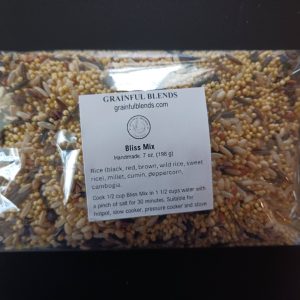Millets and Diabetes: A Scientific Exploration of Benefits, Studies, and Practical Tips
Millets and Diabetes: A Scientific Exploration of Benefits, Studies, and Practical Tips
Diabetes is a global health challenge, affecting over 537 million people as of 2021, with projections estimating a rise to 783 million by 2045 (International Diabetes Federation, 2022). Managing blood sugar levels through diet is a cornerstone of diabetes care, and one ancient grain has emerged as a powerful ally: millets. These small-seeded, nutrient-packed grains have been a staple in Asia and Africa for centuries, and modern science is now catching up to their potential in diabetes management.
In this comprehensive guide, we’ll dive into the science behind millets and diabetes, explore key studies, and offer practical ways to incorporate millets into your diet. Plus, we’ll spotlight premium millet products from Grainful Blends to help you take control of your health deliciously and conveniently. Let’s explore why millets deserve a spot on your plate if you’re managing diabetes or aiming to prevent it.
What Are Millets? A Nutritional Powerhouse
Millets are a group of small-seeded grasses cultivated for thousands of years, known for their resilience in harsh climates and impressive nutritional profile. Common varieties include:
- Foxtail Millet (Kangni)
- Finger Millet (Ragi)
- Pearl Millet (Bajra)
- Little Millet (Kutki)
- Barnyard Millet (Sanwa)
Rich in fiber, protein, vitamins, minerals (like magnesium and iron), and antioxidants, millets are naturally gluten-free and boast a low to medium glycemic index (GI). This makes them an excellent choice for blood sugar management—a key concern for those with diabetes.
The Science: How Millets Help Manage Diabetes
Scientific research has increasingly validated millets as a diabetes-friendly food. Let’s break down the evidence and mechanisms behind their benefits.
1. Low Glycemic Index (GI) for Steady Blood Sugar
The glycemic index measures how quickly a food raises blood sugar levels. Foods with a low GI (below 55) release glucose slowly, preventing spikes—a critical factor for diabetes management. A landmark systematic review and meta-analysis published in Frontiers in Nutrition (Anitha et al., 2021) analyzed 65 studies and found that millets have an average GI of 52.7 ± 10.3—about 36% lower than milled rice (71.7 ± 14.4) and refined wheat (74.2 ± 14.9). Specific millets like foxtail, barnyard, and teff scored even lower, making them standout choices.
Key Finding: The study showed that long-term millet consumption reduced fasting blood glucose by 12% and post-prandial (after-meal) glucose by 15% in diabetic individuals, dropping levels from diabetic to pre-diabetic ranges.
2. High Fiber Content for Better Glucose Control
Fiber slows digestion and the absorption of carbohydrates, leading to more stable blood sugar levels. Millets are packed with dietary fiber—far more than refined grains. A study in the Journal of Food Biochemistry (2020) found that flatbread made from millets significantly lowered blood sugar, cholesterol, and blood pressure in people with type 2 diabetes over three months, attributing this to their high fiber and protein content.
Practical Takeaway: Replacing white rice or refined wheat with millets can reduce post-meal glucose spikes, a benefit supported by multiple studies.
3. Improved Insulin Sensitivity
Magnesium, abundant in millets, plays a role in insulin sensitivity—how effectively your body uses insulin to process glucose. Research from the Journal of Food Science and Technology (2020) showed that pre-diabetic individuals consuming millets daily for weeks saw reduced insulin resistance, with fasting blood sugar dropping to normal levels. This suggests millets could help prevent the progression from pre-diabetes to type 2 diabetes.
4. Resistant Starch and Gut Health
Millets contain resistant starch, a type of carbohydrate that resists digestion in the small intestine and ferments in the colon, feeding beneficial gut bacteria. A crossover study highlighted by NutritionFacts.org (2021) randomized hundreds of diabetic individuals to consume millet daily, finding significant improvements in blood sugar control, partly due to this resistant starch and its synergy with lentils.
Why It Matters: A healthy gut microbiome is increasingly linked to better metabolic health, including diabetes management.
Key Scientific Studies on Millets and Diabetes
Here’s a closer look at some pivotal research:
- Anitha et al., 2021 (Frontiers in Nutrition)
- Scope: Largest meta-analysis to date, reviewing 65 studies with ~1,000 participants.
- Results: Millets lowered HbA1c (a 3-month blood sugar average) by 17% in pre-diabetic individuals, shifting them to normal levels. Diabetic participants saw a 12-15% drop in blood glucose.
- Conclusion: Millets outperform rice and wheat in glycemic control, making them ideal for diabetic and preventive diets.
- Ren et al., 2020 (Journal of Food Biochemistry)
- Scope: 100 type 2 diabetes patients ate millet flatbread for 3 months.
- Results: Significant reductions in blood sugar, cholesterol, and triglycerides compared to a control group.
- Conclusion: Millets’ fiber and protein content contribute to metabolic improvements.
- Agrawal et al., 2023 (PMC)
- Scope: Review of millet’s role in diabetes management.
- Results: Emphasized millets’ low GI, high fiber, and nutrient density as key factors in reducing diabetes risk and complications.
- Conclusion: Millets should be integrated into balanced diets alongside exercise for optimal outcomes.
These studies collectively underscore millets as a scientifically backed option for diabetes care, aligning with dietary recommendations from organizations like the American Diabetes Association (ADA).
Which Millets Are Best for Diabetes?
Not all millets are created equal. Here’s a rundown of the top five, based on scientific evidence and GI values:
- Foxtail Millet (GI: ~50)
- Benefits: Low GI, high fiber, and proven to lower blood sugar and cholesterol in type 2 diabetes (Ren et al., 2020).
- Try: Grainful Blends Foxtail Millet Mix—perfect for a quick, diabetes-friendly meal.
- Finger Millet (GI: ~55)
- Benefits: High in calcium and polyphenols, improves insulin sensitivity (Journal of Food Science and Technology, 2020).
- Try: Grainful Blends Ragi Flour—ideal for rotis or porridge.
- Pearl Millet (GI: ~55-65)
- Benefits: Sustained energy release and high fiber content (Frontiers in Nutrition, 2021).
- Try: Grainful Blends Bajra Mix—a versatile base for flatbreads.
- Little Millet (GI: ~52)
- Benefits: Rich in fiber and B vitamins, supports stable blood sugar (PMC, 2023).
- Try: Grainful Blends Little Millet Grain—great as a rice substitute.
- Barnyard Millet (GI: ~50)
- Benefits: Low GI and high magnesium content, excellent for glycemic control (Frontiers in Nutrition, 2021).
- Try: Grainful Blends Barnyard Millet Blend—a tasty, nutritious option.
How to Incorporate Millets Into Your Diabetes Diet
Ready to add millets to your meals? Here are practical tips and recipes:
Tips for Success
- Portion Control: Stick to 1/3 to 1/2 cup cooked millet per meal to balance carbs.
- Pair Wisely: Combine with protein (lentils, lean meats) and veggies for a balanced plate.
- Minimal Processing: Whole grains retain more fiber and nutrients than polished versions.
Easy Recipes
- Foxtail Millet Porridge
- Cook Grainful Blends Foxtail Millet Mix with water or milk, add a pinch of cinnamon, and top with nuts.
- Why It Works: Low GI and fiber-rich for a steady breakfast.
- Ragi Dosa
- Mix Grainful Blends Ragi Flour with water and a dash of salt, ferment overnight, and cook into thin crepes.
- Why It Works: High calcium and slow-digesting carbs.
- Bajra Stir-Fry
- Saute Grainful Blends Bajra Mix with veggies and spices for a hearty side.
- Why It Works: Sustained energy without sugar spikes.
Building Authority and Credibility with Grainful Blends
At Grainful Blends, we’re committed to bringing you high-quality, minimally processed millet products backed by science. Our range is sourced sustainably, ensuring you get the full nutritional benefits highlighted in studies like Anitha et al. (2021). Whether you’re managing diabetes or seeking a healthier lifestyle, our products—crafted with care—offer convenience without compromising on health.
Explore our collection at grainfulblends.com and discover how easy it is to make millets a delicious part of your routine.
Final Thoughts: Millets as a Diabetes Game-Changer
The evidence is clear: millets are more than a trendy superfood—they’re a scientifically supported tool for managing diabetes. From their low GI and high fiber to their ability to improve insulin sensitivity, millets offer a natural, affordable way to stabilize blood sugar and enhance overall health. Studies like those in Frontiers in Nutrition and Journal of Food Biochemistry affirm their potential, making them a must-try for anyone navigating diabetes or pre-diabetes.
Ready to take the next step? Start with Grainful Blends and unlock the power of millets today. Share your millet journey in the comments below—we’d love to hear how these ancient grains transform your health!







